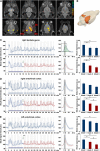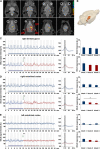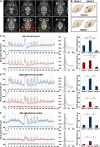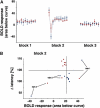NMDA-dependent mechanisms only affect the BOLD response in the rat dentate gyrus by modifying local signal processing
- PMID: 22167232
- PMCID: PMC3293123
- DOI: 10.1038/jcbfm.2011.182
NMDA-dependent mechanisms only affect the BOLD response in the rat dentate gyrus by modifying local signal processing
Abstract
The role of N-methyl-D-aspartate (NMDA) receptor-mediated mechanisms in the formation of a blood oxygen level-dependent (BOLD) response was studied using electrical stimulation of the right perforant pathway. Stimulation of this fiber bundle triggered BOLD responses in the right hippocampal formation and in the left entorhinal cortex. The perforant pathway projects to and activates the dentate gyrus monosynaptically, activation in the contralateral entorhinal cortex is multisynaptic and requires forwarding and processing of signals. Application of the NMDA receptor antagonist MK801 during stimulation had no effect on BOLD responses in the right dentate gyrus, but reduced the BOLD responses in the left entorhinal cortex. In contrast, application of MK801 before the first stimulation train reduced the BOLD response in both regions. Electrophysiological recordings revealed that the initial stimulation trains changed the local processing of the incoming signals in the dentate gyrus. This altered electrophysiological response was not further changed by a subsequent application of MK801, which is in agreement with an unchanged BOLD response. When MK801 was present during the first stimulation train, a dissimilar electrophysiological response pattern was observed and corresponds to an altered BOLD response, indicating that NMDA-dependent mechanisms indirectly affect the BOLD response, mainly via modifying local signal processing and subsequent propagation.
Figures








Similar articles
-
Field responses to perforant path stimulation in the rat dentate gyrus: role of corticosterone and NMDA-receptor activation.Brain Res. 2000 Jan 31;854(1-2):230-4. doi: 10.1016/s0006-8993(99)02268-4. Brain Res. 2000. PMID: 10784127
-
Postnatal hypofunction of N-methyl-D-aspartate receptors alters perforant path synaptic plasticity and filtering and impairs dentate gyrus-mediated spatial discrimination.Br J Pharmacol. 2024 Aug;181(16):2701-2724. doi: 10.1111/bph.16375. Epub 2024 Apr 17. Br J Pharmacol. 2024. PMID: 38631821
-
Kindling induces transient NMDA receptor-mediated facilitation of high-frequency input in the rat dentate gyrus.J Neurophysiol. 2001 May;85(5):2195-202. doi: 10.1152/jn.2001.85.5.2195. J Neurophysiol. 2001. PMID: 11353034
-
Frequency-dependent inhibition in the dentate gyrus is attenuated by the NMDA receptor blocker MK-801 at doses that do not yet affect long-term potentiation.Hippocampus. 1999;9(5):491-4. doi: 10.1002/(SICI)1098-1063(1999)9:5<491::AID-HIPO1>3.0.CO;2-V. Hippocampus. 1999. PMID: 10560918
-
The perforant path: projections from the entorhinal cortex to the dentate gyrus.Prog Brain Res. 2007;163:43-61. doi: 10.1016/S0079-6123(07)63003-9. Prog Brain Res. 2007. PMID: 17765711 Review.
Cited by
-
Characterization of NO-producing neurons in the rat corpus callosum.Brain Behav. 2014 May;4(3):317-36. doi: 10.1002/brb3.218. Epub 2014 Feb 12. Brain Behav. 2014. PMID: 24944862 Free PMC article.
-
Intrinsic organization of the corpus callosum.Front Physiol. 2024 Jul 1;15:1393000. doi: 10.3389/fphys.2024.1393000. eCollection 2024. Front Physiol. 2024. PMID: 39035452 Free PMC article. Review.
-
Functional topography of the corpus callosum investigated by DTI and fMRI.World J Radiol. 2014 Dec 28;6(12):895-906. doi: 10.4329/wjr.v6.i12.895. World J Radiol. 2014. PMID: 25550994 Free PMC article. Review.
-
Preclinical Magnetic Resonance Imaging and Spectroscopy Studies of Memory, Aging, and Cognitive Decline.Front Aging Neurosci. 2016 Jun 29;8:158. doi: 10.3389/fnagi.2016.00158. eCollection 2016. Front Aging Neurosci. 2016. PMID: 27468264 Free PMC article. Review.
References
-
- Angenstein F, Kammerer E, Niessen HG, Frey JU, Scheich H, Frey S. Frequency-dependent activation pattern in the rat hippocampus, a simultaneous electrophysiological and fMRI study. Neuroimage. 2007;38:150–163. - PubMed
-
- Angenstein F, Krautwald K, Scheich H. The current functional state of local neuronal circuits controls the magnitude of a BOLD response to incoming stimuli. Neuroimage. 2010;50:1364–1375. - PubMed
-
- Attwell D, Iadecola C. The neural basis of functional brain imaging signals. Trends Neurosci. 2002;25:621–625. - PubMed
Publication types
MeSH terms
Substances
LinkOut - more resources
Full Text Sources

